
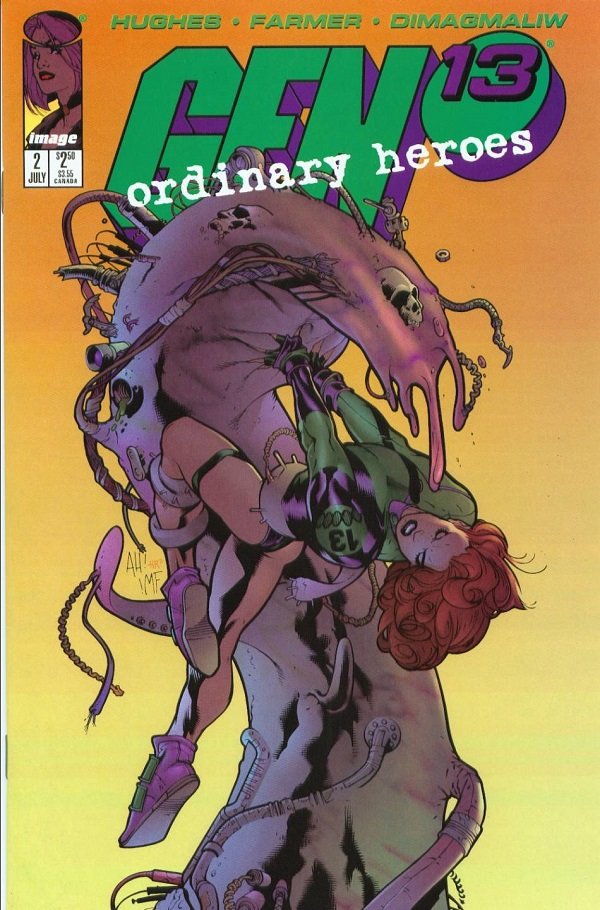
A long time ago, on a blockchain far, far away, I wrote a post about the half-dozen best Gen 13 stories from the classic era, and Ordinary Heroes wound up right on top, numero uno, number one with a bullet. In that post, I wrote that Ordinary Heroes isn't just the best Gen 13 story of all time, but one of the best comics of all time, period.
Because of that, I've been dreading getting into the weeds with it in this series. I knew I'd get there sooner or later, but as I was looking through upcoming stories to establish a chronology, I realized that like The Unreal World, there's really only one place this story fits in the series timeline. For spoiler-y reasons I won't get into here, it had to be prior to the 'Fire From Heaven' mega crossover event which cuts through issues 10 and 11. But as I moved backwards from there, the options for where to slot it kept shrinking:
- Issues 8 and 9 form a small arc of their own, but at the start of issue 8, Grunge gets a haircut; Ordinary Heroes has him with long hair, which means this has to be prior to issue 8.
- Issues 6 and 7 are another small story arc, and that story arc leads directly into the events of issue 8 (not to mention a swerve into Deathblow issues 20 and 21). Since there's no room between 7 and 8 for this story to take place, it has to be prior to issue 6.
- Issues 3 - 5 all form another small story arc, but once again, the conclusion of issue 5 leads right into the start of issue 6, meaning Ordinary Heroes has to get bumped back again. The closest place for it to go where it still fits continuity now is before issue 3. Rainmaker enjoying the eye candy of Fairchild changing clothes allows it to fit in here quite handily, given the revelation of her sexual orientation in issue 2, where the only one who knows is Freefall. Fairchild being completely oblivious makes it all the more amusing.
Ergo, this entry.
The reason I've been dreading talking about Ordinary Heroes is that I love it so much I can't stand to spoil it for unfamiliar readers. I mean, sure, the story's from 1996: its long out of college and carrying an enormous load of student debt, but you deserve to be gut-punched as hard as I was by this book's conclusion. Normally I'd split this into two entries, but if I don't get this all out of the way at once, I'm going to keep overthinking, so let's dive right in.
Ordinary Heroes opens the last way you would expect a Gen 13 story to open: with a death on the streets of a rain-soaked city.

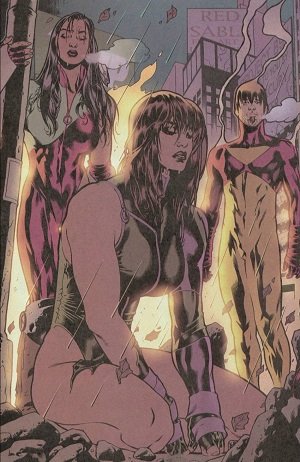
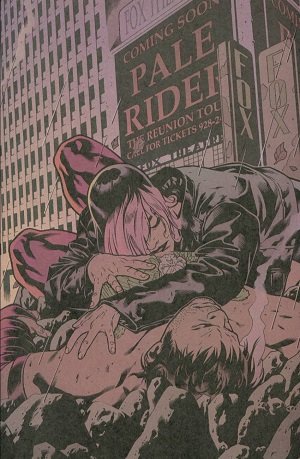
Before you can ask yourself "WT actual F?" too many times, we flash back to the day before, where everything seems perfectly normal. Fairchild is back at Princeton, though not to attend classes. If you recall, Caitlin had to leave without so much as packing or telling anyone goodbye when I/O showed up in the middle of the night. Now she's returned to pack up the remainder of her former life.
While waiting for her ride to the airport, she runs into one of her hyper-slut roommate's old boyfriends, a mullet-sporting behemoth of testosterone named Tank. While he never would have given her the time of day before, the fact she's turned into She-Hulk courtesy of her Gen-Factor manifestation means Tank's got plenty to say to her now:
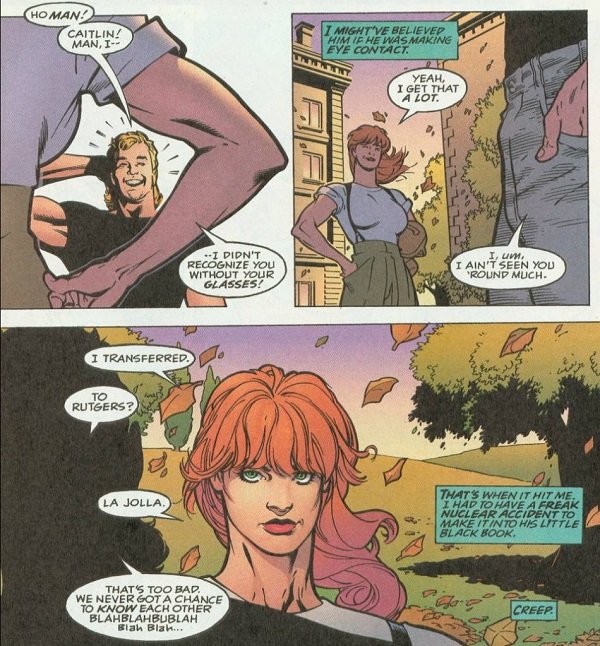
Realizing the guy's nothing more than a walking hard-on, Caitlin decides to mess with him. When he asks if she needs help, she points to the trunk holding her belongings and suggests he could carry it for her, and hilarity ensues:

Having thus ended Tank's burgeoning sports career, she hoists the trunk like it weighs nothing in preparation for her cab's arrival. Only it's not a cab that drops by to pick her up: it's a military-grade NX-2000 VTOL landing craft which sets down right on the quad. The pilot bellows for Fairchild to prepare for emergency extraction. This, Caitlin notes, goes contrary to everything Lynch has taught them about keeping a low profile. Since he's the one flying the craft and giving the orders though, he's clearly got other things on his mind.
Once aboard the VTOL, she's met by Rainmaker. Fairchild asks for an explanation, but Rainmaker replies she's asking the wrong person. Lynch hasn't told them anything except to sit down, strap in, and shut up. She takes Caitlin into the back cargo area of the VTOL, where a spare costume awaits, and as Caitlin suits up, Rainmaker explains what she knows.
In the middle of the night, Lynch received a call on a line that's never rung before. Whatever the person on the other end told him was bad news:

He bugged out immediately after telling Rainmaker and Anna to wake everyone and get them prepared for an operation. Next thing they know, he's back with the VTOL, and they were on their way to collect Caitlin. Where they're headed to now, or what they're supposed to do when they get there, is anybody's guess, and when Caitlin tries to pump Lynch for info, he makes it clear he's not telling them a damn thing.
Time passes as they continue their flight to parts unknown. After a while, the five teenagers come to a consensus: they're going to order Lynch to park the plane and explain what the hell's going on. Before they can act, the ship comes under attack by Black Hammer combat units from I/O. They peel the plane's armor like a can-opener, depressurizing the interior and blowing the five kids out into the sky. Caitlin has just one concern:
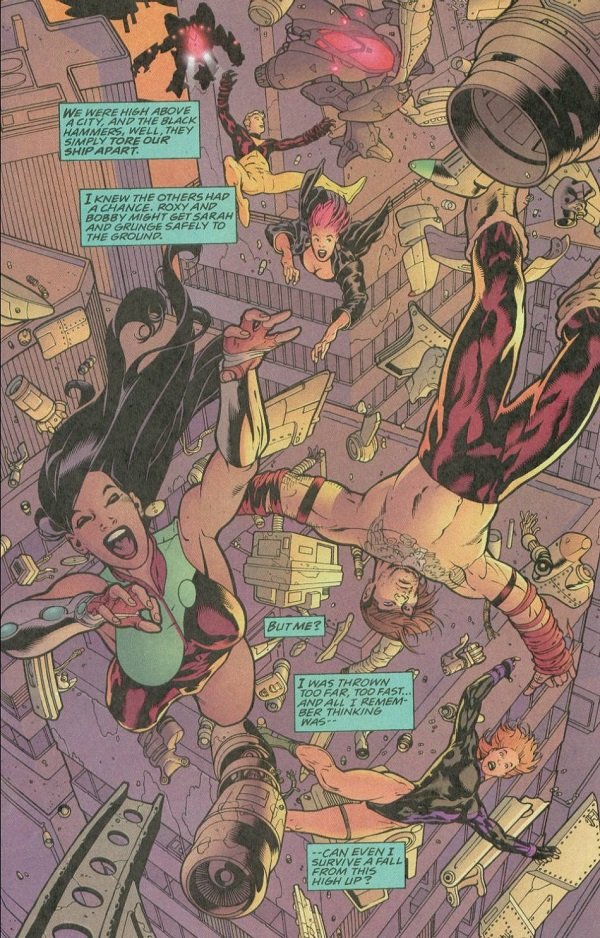
Since the alternative would take a giant dump on continuity, it turns out she can, although not without leaving a small impact crater. Staggering to her feet, she's pounced on by a Black Hammer mech, who crushes her back into the asphalt and radios in a sitrep: they've executed a Level 2 containment operation on the city. Level 1 containment is a basic quarantine and capture under I/O parameters; Level 2 is 'terminate with extreme prejudice'.
Fairchild, now thoroughly pissed off, throws the Hammer around like a toy while it peppers her with every piece of ordnance in its arsenal trying to keep her at bay. This works about as well as you'd imagine. She finally rips open the Hammer's cockpit and threatens to beat the pilot senseless unless he starts explaining, but the issue closes with Fairchild meeting the menace up close and personal:
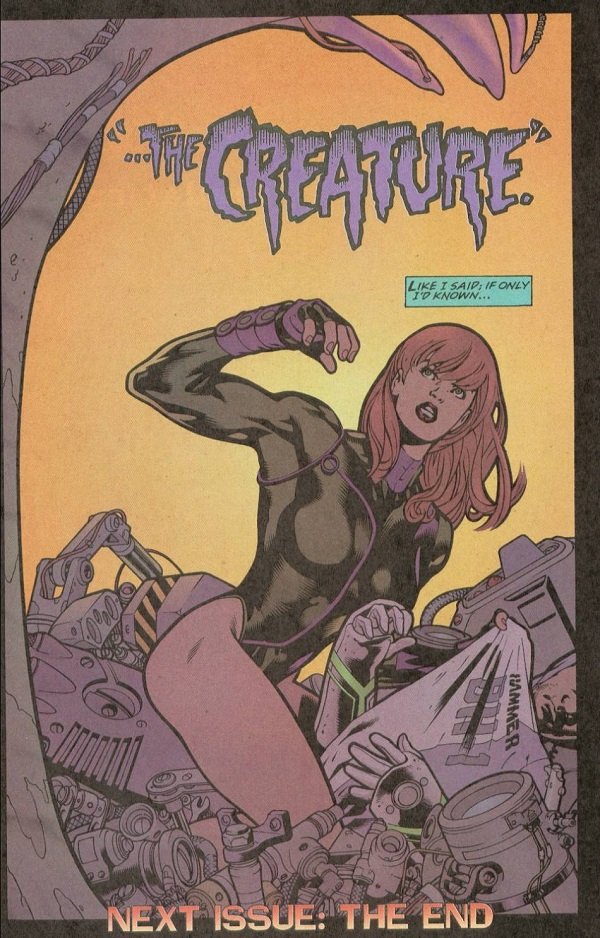
Issue 2 picks up right where Issue 1 left off, with Caitlin running in fear from the creature, dragging the hapless Black Hammer pilot behind her:

Normally, nothing scares Fairchild. When you're six feet tall, bulletproof, and can juggle trains, there's little reason to fear much of anything. But this monstrous, pulsating, tentacled reject from the hentai universe is so fast, so all-consuming in its destructive capabilities, and so beyond caring about what it devours that Caitlin's brain jams in neutral. The creature not only makes contact with her but begins snacking on one of her super-powered thighs before Freefall levitates her out of harm's way to the top of a nearby skyscraper.
Fairchild, thankful to be alive after feeling true pain for the first time in weeks, goes green and barfs up a superheroine's stomach's worth of whatever she had for her last meal.
Note: reviewer did not feel it necessary to show this scene.
After reacquainting herself with not only breakfast but also Grunge's knowledge of synonyms for puking, the team regroups, assuming the creature that nearly ate Caitlin is what Lynch was taking them to fight. Without him there to brief them though, they have no idea what they're up against or what he planned to have them do. And while the creature has wiped the floor with the rest of the Black Hammer team, there's one survivor who happens to be a familiar face: Rebecca Hawkins, whom you might remember from Issue #5 of the limited series as having saved their butts once before:
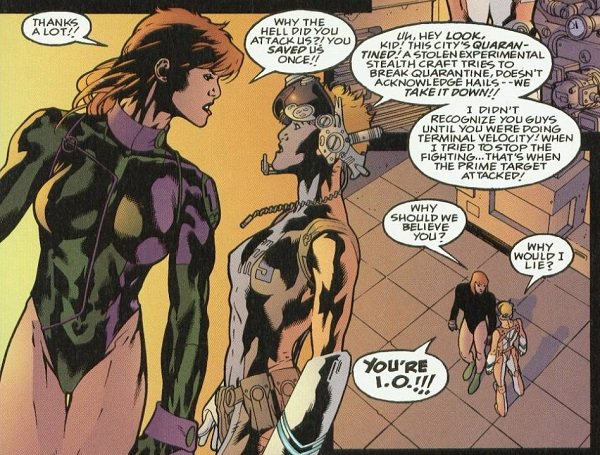
Still angry that Lynch didn't trust them enough to tell them about the creature, Hawkins tries to put things in perspective. Just like you don't teach six-year-olds about the Holocaust, Lynch isn't about to info-dump all of I/O's dirty little secrets on a bunch of teenagers. "There are some things man was not meant to know," Hawkins said. "Jack Lynch knows."
He wasn't infantilizing them by withholding information, he was trying to protect them from a fraction of the skeletons he's carrying around in his closet. As a former high-level member of International Operations, there's little of the group's work Lynch didn't know about. This creature appears to be one of those things. Unfortunately, Hawkins is just a grunt. Her orders were to quarantine the monster within the city and destroy it. With the destruction of her Black Hammer squadron, she's at a loss for what to do. That means they need to find Lynch as soon as possible, which means locating their downed craft and hoping Lynch survived the crash.
As they walk, Hawkins explains what she knows about the creature: it's a metamorph, capable of re-writing its DNA and RNA on the fly. It eats by directly ingesting living matter, but can also assimilate bits of technology as well. If the titular Thing from John Carpenter's film wasn't concerned with hiding itself, but rather wanted to take over the planet as quickly and completely as possible, you'd get something akin to this creature.
Thankfully, despite night falling and the onset of a storm, they manage to locate what's left of the VTOL. Unfortunately . . .
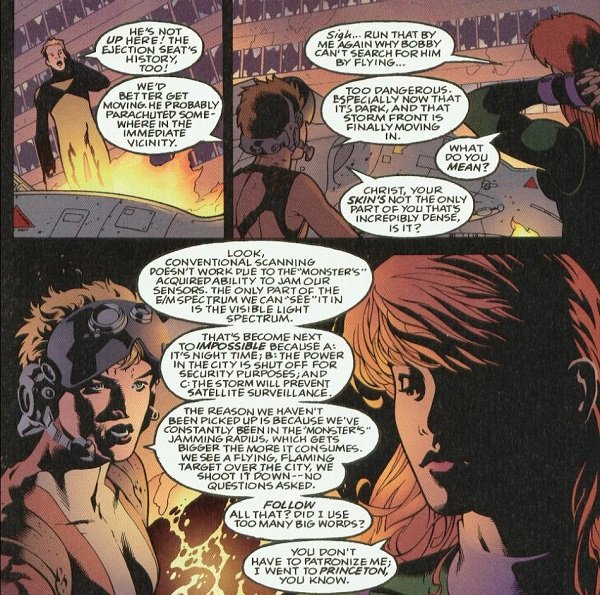
Proving what a stone-cold badass he still is, Lynch shows up, having hobbled his way seventeen blocks back to the landing site on a shattered ankle. As Hawkins suspected, he had a contingency plan in place, but when Burnout rummages through the wreckage, he finds said plan a melted, ruined mess. Now out of options, Fairchild convinces Lynch to square with them and explain what they're fighting.
The truth comes out:
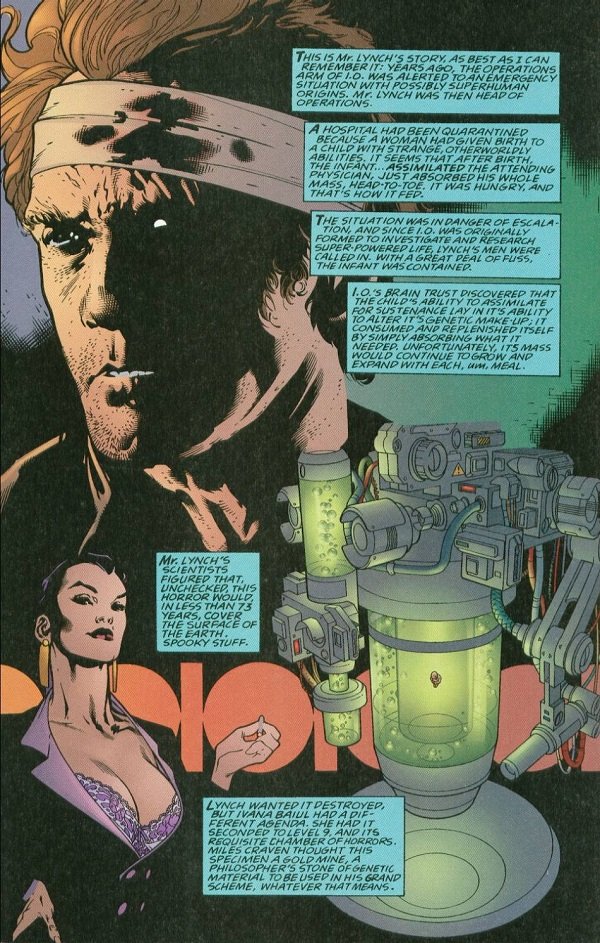

The Black Hammers, Lynch, and the Gen 13 kids were all dispatched to kill a baby.
What's worse is what will happen if they fail. International Operations has a fallback option involving Atomic Vector Cannons, which Lynch is convinced will not work. When that fails, I/O will adopt a scorched Earth policy that will obliterate the creature, but at the cost of at least fifty percent of the state's population (not to mention the seven of them). We aren't told where this takes place, but it's safe to assume the city is a major metropolis. A 50% casualty rate is millions of innocent lives.
The alternative is that the creature continues to grow and devour everything it touches, endangering the entire world.
Kobayashi Maru, anyone?
Don't worry, it gets better:
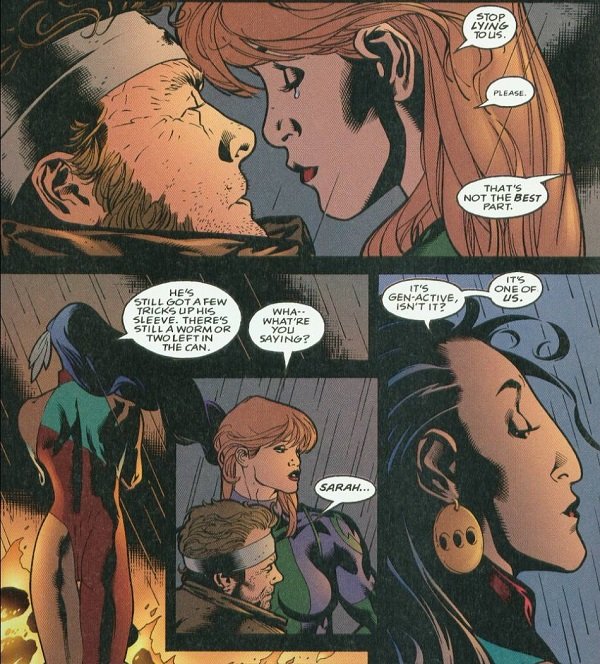
Rainmaker's no idiot. The creature they're fighting is Gen-Active. Only instead of manifesting through tampering by I/O, it manifested from the trauma of its own birth. It's Gen 13, just like they are.
Burnout doesn't understand what the problem is: it's a creature that has already killed, and will continue to do so unless it's destroyed, a sentiment likely shared by a certain percentage of readers. But once again, Rainmaker's the group's conscience and she lays into Burnout (and, by proxy, any reader who sympathizes):
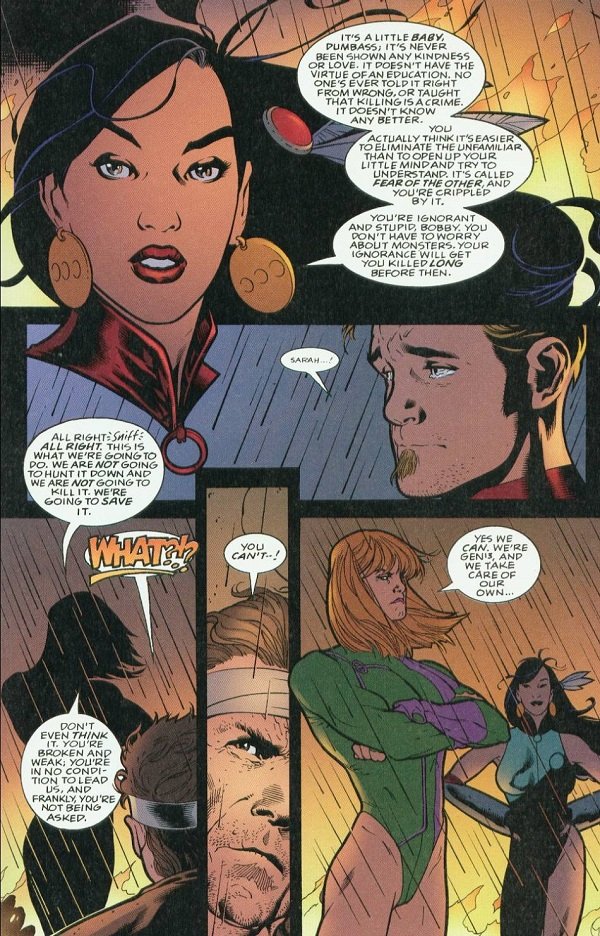
Lynch gets Hawkins to spill the plan for the Black Hammer assault. With this intel, Fairchild decides the first order of business is to spoil I/O's incoming assault. The hour-long fight with the Hammers is condensed into a single two-page spread, with Fairchild delivering a beautiful soliloquy on the way her team deals with situations:
You know, I can't ever remember performing an act of aggression before my manifestation. I never made a fist or caused anybody any harm, ever. But now, it's all I do. All I ever seem to do is punch and kick and destroy. Why couldn't I have been given a better gift; something that could add to the human condition, make some sort of difference. Why is my only gift a marked capacity for wanton violence and destruction?
Unfortunately, while Gen 13 is pounding on the Hammers, the creature arrives on the scene. Grabbing the closest Hammer, it absorbs it in seconds: the pilot, the gunner, and (uh-oh) the Atomic Vector Cannon.
The child frags the remaining Black Hammer with its newest power, and now Rainmaker's at a complete loss. How do you communicate "we mean you no harm" to someone that has no idea what that gesture looks like? For all her words earlier, Rainmaker doesn't have the answer. Fairchild doesn't know. Freefall and Burnout are likewise clueless.
It thus falls to Grunge to find a solution, though it'll be the last thing anyone suspects:

I will not spoil the last three pages of this story.
I will not do it.
The ending ravages the fuck out of me emotionally every time I read it, and you deserve to experience the same.
Maybe @cryplectibles, or @blewitt, or someone else here on the blockchain has a copy that they'll sell you. There's also a collected edition if TPBs are more your thing. It's inexpensive online, a few dollars at most. Well worth the price of admission. Just bring your tissues--this is one story where you're allowed to cry at the end.
Final Score:





 out of
out of 




(No, you aren't seeing things -- that's six @blewitt faces out of five).
Ordinary Heroes was written and penciled by Adam Hughes. In fact, this is the first book he ever worked on. Ordinary Heroes has no right to be as good as it is, but damn it if Hughes didn't walk up to his first time at bat and swat a game-winning, bases-clearing Grand Slam. Mark Farmer's inks are superb, and Homer Reyes's colors are on point, but this is absolutely the Adam Hughes show from start to finish, from script to page layouts. This guy gets comics, and there isn't an out-of-place panel in the bunch.
Ordinary Heroes may not be the type of story we started reading comics for, but it's the sort of story that the medium is best equipped to tell. I can count on one hand the number of times a funny book has reduced me to tears, but Ordinary Heroes ticks that box every time I crack the covers. Despite no prior experience writing these characters, Hughes possessed an intuitive understanding of just what made Fairchild, Rainmaker, Freefall, Grunge, Burnout, and Lynch tick.
If there's any criticism to be leveled at the story, it's that Freefall and Burnout are massively underused compared to the other kids, but the story flows so well you won't notice. It's interesting to note that while Grunge winds up being the team's savior in both this and The Unreal World, it's a different type of heroics that result in saving the team both times. In The Unreal World, Grunge saves the day because Lynch tells him what to do. Here, Grunge comes up with and executes the plan entirely on his own. Considering it's only been a short time between both of these adventures (and how Grunge's first appearance in this story involves an armpit fart noise contest), that's damn impressive.
That's it. I'm out of words. Ordinary Heroes is so good it beat out even my own fanboyish love for Adam Warren in my list of best Gen 13 stories. If you read only one 90s comic in your entire life, for god's sake, make it this one.